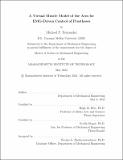A Virtual Muscle Model of the Arm for EMG-Driven Control of Prostheses
Author(s)
Fernandez, Michael F.
DownloadThesis PDF (6.689Mb)
Advisor
Herr, Hugh M.
Terms of use
Metadata
Show full item recordAbstract
Existing upper extremity prosthesis controllers are unable to provide effective control for persons with amputation, contributing to device abandonment rates as high as 50%. Neuromuscular modeling provides a powerful tool for the development of custom controllers to improve the clinical efficacy of prostheses.
This thesis develops techniques for the creation of models of the arm using a reduced number of virtual muscles. These models take electromyography collected from the residual limb to estimate intended movements for prosthesis control. Neuromuscular model optimization and forward dynamics simulation are used to find parameters that fully define antagonist pairs of virtual muscles that actuate each model degree of freedom. Patient-specific models can be tailored to the morphology of patients with agonist-antagonist myoneural interface (AMI) constructs with minimal hand tuning.
As a case study, a four degree-of-freedom arm model (allowing elbow flexion, index flexion, 3rd to 5th digit flexion, and thumb abduction) was optimized for a subject with unilateral transhumeral amputation who possesses two AMI constructs. The resulting model outputs kinematics that closely match measured kinematics. Joint angle predictions for the elbow, digits, and index finger were very highly correlated with reference trajectories (r = 0.92, r = 0.91, and r = 0.87, respectively), while predictions for the thumb were only moderately correlated (r = 0.55). The optimized model also shows the speed-accuracy tradeoff as quantified by Fitts' Law and achieves some degree of graded control.
These results demonstrate how patient-specific neuromuscular models can replicate characteristics of volitional motor control. The highly intuitive control and restoration of native biomechanics granted by such biophysical controllers can allow persons with amputation more independence, raising their quality of life.
Date issued
2022-05Department
Massachusetts Institute of Technology. Department of Mechanical EngineeringPublisher
Massachusetts Institute of Technology